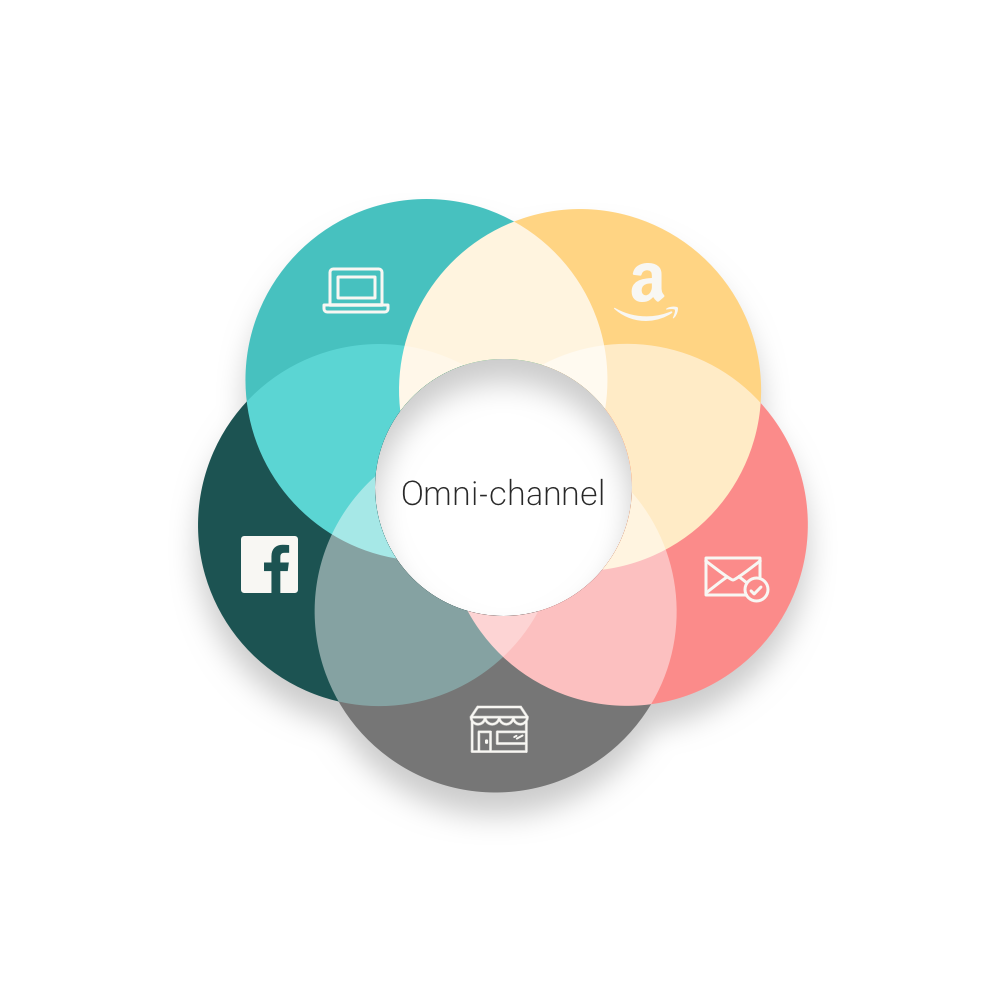An Omni-Channel Commerce Solution
What Is an Omni-Channel Commerce Solution?
Omni-channel commerce is a fully-integrated approach to sales and marketing that gives shoppers a unified experience across online and offline channels.
Omni-channel commerce solutions extend from brick-and-mortar to online stores and encompass …
- Ecommerce marketplaces
- Mobile websites and applications
- Social marketing, retargeting, and sales
- Messaging and SMS
- Deeply personalized email marketing
- And everything in between

The aim is to bring together all these features — including, multi-channel listing, POS integration, and inventory management — to provide customers with a single buyer’s journey from platform to platform.
Even more importantly, they allow companies to connect and overlap each channels’ data for a seamless view of the customer themselves.
Without a true omni-channel solution, companies are left with no way to translate data from in-store purchases to online retention to marketing efforts and back again.
Why Invest in an Omni-Channel Commerce Solution?
With the current barrage of retail store closures, it’s easy to paint retail in a negative light. Rising online purchase rates lay behind the so-called “inevitability” of retail’s demise.
The problem, however, isn’t rooted in retail shopping.
With global retail sales projected to hit $27.73 trillion in 2020, the problem is that companies are struggling to keep up with changing consumer behavior. Adaptation has been too slow and unable to meet the customer’s growing demand that won’t accept lackluster experiences.
According to the Periscope Research, 78% of retailers admit that they don’t give consumers a “unified brand experience.”
Common reasons for this lack of brand transcendence include struggles with:
- Internal organization
- Customer analytics
- Data sharing and alignment
- Siloed departments
- Identifying shoppers across channels
Lack of brand unity is particularly disconcerting because 31% of people use five or more devices to connect to other humans, businesses, and experiences:
The desire to be connected — to experience a brand and not just buy from it — is why omni-channel retailing is necessary for any company seeking to avoid retail’s grim outlook.
big-picture data confirms that omni-channel commerce works.
According to the Harvard Business Review, among 46,000 participants of a recent study:
“Only 7% were online-only shoppers and 20% were store-only shoppers. The remaining majority, or 73%, used multiple channels during their shopping journey.
“In addition to having bigger shopping baskets, omnichannel shoppers were also more loyal.
“Within six months after an omnichannel shopping experience, these customers had logged 23% more repeat shopping trips to the retailer’s stores and were more likely to recommend the brand to family and friends than those who used a single channel.”
An IDC report found that retailers using omni-channel commerce solutions saw a 15-25% increase in average order values, 5-10% increases in customer profitability, and 30% higher customer lifetime value.
This can be seen everywhere in retailers who are succeeding.
Amidst doomsday headlines, Ulta Beauty drove $4.85 billion in revenue in 2017, up from $3.9 billion in 2016. How? Michelle Pacynski, VP of Ecommerce at Ulta Beauty, explains:
“A key objective for guest-facing systems is to drive a consistent experience regardless of the way she wants to shop. So whether that’s in store, in our mobile apps, or online, we feel that we can provide a single brand experience across all channels.”
How to Pick an Omni-Channel Commerce Solution?
(1) Multi-Channel Listing
Multi-channel listing and selling is a key ingredient in any successful omni-channel strategy. In essence, multi-channel ecommerce is about giving customers a choice in where they purchase:

(2) Point-of-Sale Integration
Point-of-sale (POS) integration is at the heart of a powerful omni-channel commerce solution. Utilizing technology that allows companies to collect user information directly at the POS makes it easier to sell products and accept payments on any channel.
Bonobos’ Guideshops enable sales reps at the store to bring the POS system with them on iPads, storing and logging customer data as they try on new clothes. That data then gets routed to the customer’s individual login online.
(3) Inventory Management
When it comes to omni-channel commerce, inventory management is critical. If someone wants to purchase on Facebook or through a retail location, inventory levels have to also be updated onsite and across your backend systems.
you can automatically sync inventory and order in real-time across every channel you manage.
This includes both online and offline sales channels from social to mobile apps as well as third-party marketplaces like Amazon and eBay. No matter where the customer purchases or wants to purchase, your inventory will sync.
(4) Marketing Integration
A consumer’s overall omni-channel experience has to transcend each individual platform. Outfits examined in store should directly translate back to the user’s mobile app and online shopping cart.
According to a DigitalCommerce360 study, companies that integrate marketing between each channel retains an average of 89% of their customers from channel to channel.
Meanwhile, those with weak marketing integration only retain 33%.
This level of offline to online integration is exactly what an omni-channel commerce solution should contain.
With a growing amount of users inspecting products in-store using their phone, this meets consumer demand and allows for a seamless experience between channels.
Final Thoughts on Your Omni-Channel Commerce Solution
Retail isn’t dead. Rather, old strategies are simply failing to capture interest.
While media portraits of retail sound dreary, thinking one level deeper makes opportunities apparent and paints a positive picture of the future …
Omni-channel solutions are proven technologies that utilize multi-channel listings, POS integration, inventory management, and diverse marketing software to seamlessly transmit customer data to each step of their buying process.
With retail speculations trending negatively, omni-channel commerce solutions offer hope for the connected future.
Source: An Omni-Channel Commerce Solution: The What, Why, and How of Retail’s Future
